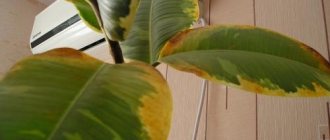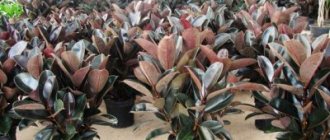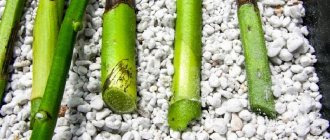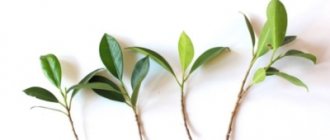This plant does not like frequent transplants; their need is justified only if parts of the roots begin to appear in the drainage hole of the pot. This means that the ficus has outgrown the capacity of the container and is cramped. On average, an adult culture is moved to a new larger container every three years, young ones - every year. When carrying out the procedure, it is important not to damage the root system and do not forget to fill the bottom with expanded clay. According to the advice of most lovers, if there is no need to move the flower, it is worth updating the top layer of soil every spring.
Features of the plant type with photo
The ficus is native to India and Indonesia, where the plant grows as an evergreen tree and reaches 30 meters in height. Many varieties of its decorative foliage indoor analogues have been developed. The rubber-bearing ficus is also called elastica, and it received the prefix “rubber-bearing” for the presence in its juice of a substance from which rubber can be made. Belongs to the Tutov family.
Characteristic features of elastic:
- dense oval-shaped leaves with pointed tips;
- The color of the leaves can be dark green, burgundy, and also with light splashes;
- the stem is strong, in adult plants it is tree-like;
- has milky juice with a high isoprene content;
- the tree is capable of flowering, but produces flowers quite rarely;
- elastica rarely produces side shoots without outside help;
- prefers an average temperature of 16-18 degrees;
- reproduces in several ways.
Several varieties of this species have been bred, which differ in appearance and care characteristics:
- Melanie;
Melanie - Belize;
Belize - Robusta;
Robusta - Tineke;
Tineke - Black Prince;
Black Prince - Abidjan;
Abidjan - Tricolor;
Tricolor - Sriveriana;
Sriveriana - Variegata.
Variegata
The houseplant is easy to care for and does not require additional expensive fertilizers. The tree grows quickly and has a long lifespan.
You may be interested in:
How to care for geraniums in winter? Many women love to grow flowers at home, because it’s not only beautiful, but there’s something to do with their free time....Read more...
Origin
The rubber plant is native to Southeast Asia. Or rather, the expanses of India, China, Sumatra and Java. The subtropical regions of these countries and islands are best suited for the plant to grow in natural conditions. This tree has been in cultivation since the beginning of the 19th century. It is usually grown in specially selected large flowerpots. The growth of the giant is limited precisely by the dimensions of the container.
In the natural environment, its height can reach 50 meters. With proper environmental humidity, rubber plants are able to develop aerial roots. They spread in all directions.
Preparing cuttings for propagation, rooting
The simplest and most popular way to propagate elastica is to use cuttings. It is best to carry out the procedure between March and June. In order for the transplantation process to be successful, you should choose adult ficuses that already have lignified shoots. The algorithm for preparing cuttings is as follows:
- You need to cut a cutting 10-15 cm long at an angle. Both the top of the plant and the side shoot are suitable for this purpose.
Ficus cuttings - The cut must be thoroughly washed under running water or soaked for a couple of hours in warm water until the milky juice, which forms a plug on the cut, completely disappears.
- Make several vertical cuts at the bottom of the branch and tear off the lower leaves. Only after this can you move on to rooting it.
- The first option is rooting in water. You need to place the shoot prepared in this way in water and wait for the roots to appear. To speed up the procedure, you can use special biostimulants or activated carbon.
Advice!
It takes 3-4 weeks for the flower to take root. Creating a greenhouse effect will help speed up the process of root emergence. Simply place a plastic bag or plastic bottle over the branch. You should not forget to add water to the container during the process of germination of the cuttings.
Germination of cuttings
The first sign of the appearance of roots will be the formation of white nodules in the area of the cut, which will soon turn into roots. The next step in obtaining a new young ficus will be planting sprouted branches with young roots in the soil.
Apical cuttings
In spring, ficus trees are pruned to ensure proper growth. The apical shoots make excellent planting material. But there are a number of conditions:
- Cuttings should not be less than 15 cm, each should have 3-4 full leaves.
- It is better not to use completely green shoots (and they are often found at the top of the bush). The branch has not yet gained the strength to grow and will not be able to take root. It is better to choose semi-lignified shoots.
Before planting ficus cuttings, you need to properly prepare them:
- Cut to the desired length, make an oblique cut at the bottom. The top point of the bottom cut should be as close as possible to the kidney.
- Remove the bottom sheet and cut off half of the rest.
- Place the branches in water. This will prevent the sticky, whitish juice from hardening in the air. Keep for 3-5 hours. At this stage, you can add various phytostimulants such as “Kornevin” and similar drugs.
- Remove from the water and dry the sections for 15-20 minutes. Dust all damaged areas with coal dust. You can also dip the cut in a powdered growth stimulator.
The cuttings are ready. Now they need to be rooted and then transplanted into the ground.
Planting cuttings
To plant a prepared cutting, you will need a mixture of substrate and a container, which does not have to be large, since after the start of the active growth phase it will be possible to transplant the elastica into a more suitable pot.
It is necessary to prepare the following substrate for the successful development of a young plant:
- peat – 1 part;
- sand – 1 part;
- drainage – 1 part;
- leaf soil - 5 parts.
For sterilization, it is also recommended to water this substrate with a solution of potassium permanganate and, after drying, begin planting the plant. The procedure for planting cuttings is standard; you need to make a hole and moisten the soil, loosen it and then place the sprout in the hole made, keeping as close to the center as possible.
Rooted cuttings
From side shoots
Planting material can also be prepared from lateral semi-lignified long shoots. The branch is cut into 15-20 cm pieces, with 4-5 leaves on each. They are prepared for planting in the same way as the apical ones. But stem cuttings from side shoots take root much more slowly, and some of the planting material dies. If you use growth stimulants – liquid and powder – the result will be better.
Caring for young ficus trees
A young plant requires special care in the first two months, as during this period it gains strength and becomes a full-fledged independent ficus. It is important to adhere to the following rules when caring for young elastics:
- Choose a place with good lighting but not direct sunlight. This will allow the small ficus to grow and gain strength, maintaining the shape of the leaves and strengthening the stem. If there is too much light, it will stretch upward, and the leaves will not be able to fully bloom and, most likely, will dry out.
Ficus care - Depending on the time of year, you need to maintain the temperature: in winter – 15-18°C, and in summer – 25-28°C.
- Avoid drafts, they are harmful to the developing sprout.
- Proper watering is the key to a beautiful and healthy plant. Young elastic needs to be moistened every 3-5 days, depending on the ambient temperature.
Important!Do not overdo it, so as not to flood it, stick to the watering regime, since dry soil will not allow the young sprout to develop fully. It is also important to wipe the leaves or spray them with a spray bottle.
- Feeding of young ficus in the active growth phase should be introduced from the second week from the day of planting in the soil and should be done every 10-14 days; it will give strength to the roots of the plant and also help the development of new leaves. A universal fertilizer for deciduous plants is suitable for this purpose.
You may be interested in:
Propagation of black currants by cuttings in summer A berry grown with your own hands will be much tastier. With the help of cuttings, a plant can help in 1 year...Read more...
By adhering to these simple rules, you can grow ficus yourself from cuttings and soon get a new plant that is pleasing to the eye at home.
Leafy
Many people want to know how to grow ficus from leaves. The fact is that only this part of the plant can be “borrowed” unnoticed. There is a sign that only a “stolen” plant takes root well, so amateur flower growers carry various leaves when visiting.
Leaf cuttings are a good method, but only for ficus plants with thick, fleshy leaves and large veins. It is useless to propagate the small-leaved ficus benjamina.
If possible, the leaf is cut off with part of the cutting. Then the plate is rolled into a loose tube and tied with thread. The cuttings are rooted only in the ground.
A separate leaf should also be planted with its lower end in moist, loose soil.
Possible problems and methods for solving them
The rubber-bearing species is rarely susceptible to disease and is not particularly demanding on living conditions, but still the plant can also suffer if it is not cared for properly or pests appear. Common problems when caring for elastic:
- Incorrect watering, which leads to drying out or, conversely, waterlogging of the elastic. If it dries out, the watering regime should be normalized, and the plant will recover. If it was flooded and the roots began to rot, then you can try to save the flower by replanting it in new soil and removing the damaged roots.
- Yellowing of leaves due to excess light or excessive proximity of heating devices to the flower. You just need to move the ficus to another place - and it will regenerate on its own.
Yellowing of leaves - Ficus leaves can also turn yellow due to excess fertilizer; to remove them, it is enough to water the flower generously several times and reduce the dose of the drugs used in the future.
- Elastic develops poorly and takes on an unhealthy appearance if there is an excess of salts in the soil. The problem is solved with the help of a transplant.
Ficus can also suffer from insects; it is advisable to detect their attack on the plant at an early stage and get rid of them. Signs of ficus damage by pests manifest themselves in different ways:
- aphids cover the leaves with sticky clumps;
- as a result of a scale insect attack, brown-white tubercles appear on the leaves;
- spider mites can be noticed by the appearance of a thin cobweb enveloping both the trunk and leaves;
- Mealybugs are characterized by the appearance of fluffy white fibers and sticky liquid on the leaves and stem.
To rid elastic from pests, you need to carefully treat it with special chemicals that are sold in flower shops. You can also use traditional methods of struggle:
- laundry soap;
- toothpaste;
- garlic;
- tobacco;
- nettle;
- calendula;
- elder;
- sagebrush.
You need to prepare an aqueous solution from the above plants and products and thoroughly rinse the ficus with it to get rid of insects. The procedure is effective at the initial stage of infection and requires repetition several times to achieve results.
Proper transplantation into a new flower pot
The only important rule is to observe the seasonality of the procedure. The flower tolerates this event best in the spring. The best option would be to replant and prune with annual alternation, so the ficus adapts more easily each time and recovers faster.
A young plant should not be planted in a large pot, otherwise the root system, sensing space, develops too intensely, leaving no energy and nutrients for the growth of the above-ground part. Each time you need to choose a container 6 centimeters deeper and larger in diameter than the previous one.
The least traumatic way is transshipment. If this is not possible, you need to protect the root system as much as possible from external influences and place it in a new pot at the same level as in the previous place. When carrying out care that involves damaging parts of the plant, it is necessary to use gloves, since the secreted juice contains poison that can cause swelling or irritation of the human mucosa.
Interesting! Read about the beautiful Ficus elastica.
Growing rubber-bearing large-leaved ficus is absolutely not difficult; it is not capricious in rooting and easily tolerates transplants at a young age. In addition, a grower who pays due attention to it and carries out the necessary pruning annually has the material to begin propagating the crop using the common vegetative method.
How to trim rubber ficus and form a crown, watch the video:
Ficus tolerates pruning well at any time of the year, but is most responsive to it in late spring and early summer. Experts consider this time to be the most favorable for all types of pruning. Sanitary pruning can be done as needed: remove weak and damaged branches at your convenience.
When working, be sure to wear rubber gloves to protect yourself from the poisonous juice.
Advice from flower growers
The rubber ficus is an unpretentious plant because it does not require special care. However, he is also sick. It is worth considering the most common diseases and their causes.
- The leaves have turned yellow. If you care for your ficus incorrectly, the leaves will begin to turn yellow. The reasons include the wrong size of the growing container, high content of fertilizers, especially salts, and the presence of rot on the roots.
- Leaves fall. Usually old leaves fall off naturally. If a plant “loses” young foliage, then the reasons may be increased soil moisture, rather infrequent watering, lack of lighting, sudden changes in temperature or the presence of drafts.
- The plant doesn't grow. The reason for this may be a cramped pot, a minimum of nutrients, or a lack of light.
The rubber plant is a luxurious plant with large, shiny leaves. It looks great in various interior styles, and also perfectly purifies the air, so it is in high demand among gardeners.
To learn how to propagate ficus at home, see the following video.
Botanists count about a thousand species of ficus and more than two thousand of their varieties. Known are giant and dwarf ficuses, shrubby, tree-like, creeping, climbing, with leaves different in shape and size, fruit-bearing and sterile.
And they reproduce in different ways - by air layering, seeds, leaves. However, there is a simple and reliable way to propagate any type of ficus at home - cuttings.
Common mistakes
Before transplanting a ficus (with cuttings, leaves, layering - it doesn’t matter), you need to thoroughly treat all equipment with any antimicrobial agent or pour boiling water over it. This will also help get rid of pest larvae when using a used pot.
Common mistakes that novice gardeners make include:
- Excessive watering. Leads to root rot and plant death.
- Abuse of fertilizers. Sometimes a gardener who carefully cares for his plants has all his bushes wither and wither, while in a stuffy office the ficus feels great. And in this case, it’s most often a matter of banal overfeeding.
- No household humidifier or daily spraying.
- Rooting of an immature leaf - without a stem or bud. Even if the bush grows from such unsuitable material, it will be weak and undeveloped.
Source











